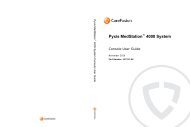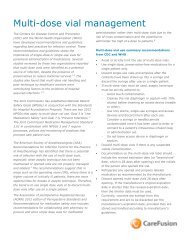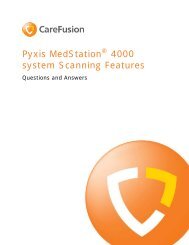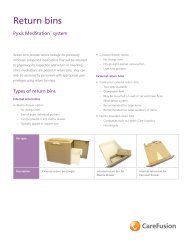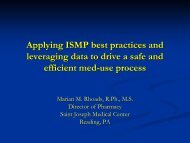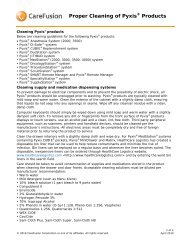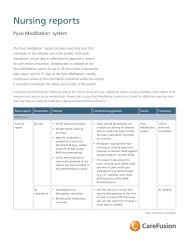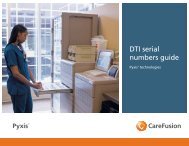BioID fingerprint identification system - The Pyxis ® Insider newsletter
BioID fingerprint identification system - The Pyxis ® Insider newsletter
BioID fingerprint identification system - The Pyxis ® Insider newsletter
You also want an ePaper? Increase the reach of your titles
YUMPU automatically turns print PDFs into web optimized ePapers that Google loves.
<strong>BioID</strong> <strong>fingerprint</strong> <strong>identification</strong> <strong>system</strong><br />
<strong>The</strong> next generation technology<br />
Executive summary<br />
<strong>The</strong> <strong>BioID</strong> <strong>fingerprint</strong> <strong>identification</strong> <strong>system</strong> on<br />
the <strong>Pyxis</strong> MedStation 4000 <strong>system</strong> includes<br />
biometric sensor technology that provides reliable<br />
authentication and identity verification in healthcare<br />
settings, accommodating multiple environmental and<br />
demographic variables. In this technical whitepaper,<br />
we will provide an overview of biometrics applications<br />
in healthcare, a brief discussion of how biometrics work,<br />
an overview of technical challenges for biometrics<br />
in healthcare settings and a thorough discussion of<br />
the third-generation biometric solution for the <strong>BioID</strong><br />
<strong>fingerprint</strong> <strong>identification</strong> <strong>system</strong>.<br />
Biometrics applications in healthcare<br />
Biometrics play an important role in healthcare applications,<br />
especially when there is a need to control access through<br />
positive <strong>identification</strong> of authorized users. Biometrics<br />
also facilitate operational efficiency in healthcare by<br />
providing quick and easy access—reducing costly workflow<br />
interruptions that occur when passwords are forgotten or<br />
access cards are misplaced. <strong>Pyxis</strong> medication dispensing<br />
technologies were the first automated dispensing devices<br />
to widely deploy a biometrics solution to meet the needs of<br />
the challenging healthcare environment. Today, millions of<br />
Nurses access secured <strong>system</strong>s using <strong>BioID</strong> to care for their<br />
patients every day.<br />
Biometrics overview<br />
Biometric <strong>system</strong>s provide a means of verifying identity by<br />
collecting information about unique human characteristics<br />
and comparing that information to previously-submitted<br />
data. <strong>BioID</strong> incorporates a biometric sensor that collects<br />
information about users’ unique <strong>fingerprint</strong>s and a<br />
matcher that facilitates decisions on whether access<br />
should be granted to the user based on data collected<br />
from the sensor.<br />
<strong>The</strong> user places a finger on the external surface of the<br />
sensor, or platen, and relevant information is quickly<br />
extracted and transformed into a digital representation of<br />
the user’s <strong>fingerprint</strong>, or template. A template is not an<br />
image of a <strong>fingerprint</strong>, and <strong>fingerprint</strong> images cannot be<br />
restored from the encoded templates.<br />
<strong>The</strong> user’s template is compared to the reference template<br />
the authorized user provided during an initial enrollment<br />
process. If the two templates match, the user is granted<br />
access. <strong>The</strong> entire process, from finger placement to match<br />
result, takes place in approximately two seconds with<br />
the <strong>BioID</strong> <strong>fingerprint</strong> <strong>identification</strong> <strong>system</strong>.<br />
Understanding biometric performance<br />
In order for a biometric deployment to be successful, the<br />
<strong>system</strong> needs to be able to quickly and reliably accept<br />
authorized users and reject unauthorized users. <strong>The</strong> two<br />
most common metrics for assessing biometric performance<br />
are the false accept rate (FAR) and the false reject rate<br />
(FRR). FAR measures the number of times the <strong>system</strong> allows<br />
access to someone who is not enrolled in the <strong>system</strong>. A<br />
high FAR exposes the <strong>system</strong> to security risks. FRR measures<br />
the number of times an authorized user is not recognized<br />
by the <strong>system</strong>. A high FRR creates hassles for authorized<br />
users who must try again or use an alternative method of<br />
gaining access.<br />
<strong>The</strong> success of a biometric deployment also depends on<br />
how many authorized users can actually use the <strong>system</strong>.<br />
Failure to enroll (FTE) measures that portion of the<br />
authorized population that cannot use the <strong>system</strong> because<br />
the sensor cannot read their unique biometric information.<br />
<strong>The</strong>se people will be unable to enroll in the <strong>system</strong> because<br />
the <strong>system</strong> will never recognize them. <strong>The</strong> failure to acquire<br />
(FTA) rate measures the number of times a sensor does<br />
not collect any biometric data at all. A high FTA rate slows<br />
<strong>system</strong> throughput.<br />
1
Bringing biometrics to healthcare: the challenge<br />
A sensor’s ability to collect usable data can be influenced<br />
by various external conditions, including demographic<br />
variables, users’ skin conditions, environmental variables<br />
and throughput requirements—making healthcare a<br />
particularly challenging environment.<br />
• Diverse user population: Demographic variables<br />
such as ethnicity, sex and age all affect biometric<br />
performance and the diverse user population in<br />
healthcare has historically presented a challenge<br />
to conventional biometric <strong>system</strong>s.<br />
• Hand washing protocols: Hospital policies require<br />
frequent hand washing and sanitizing for Nurses<br />
and others who come into contact with patients.<br />
Such users commonly have either very dry fingers<br />
or overly moisturized fingers. Both conditions can<br />
negatively impact an individual’s ability to enroll or<br />
use a <strong>fingerprint</strong> biometric <strong>system</strong>.<br />
• Environmental conditions: Hospitals are often kept<br />
cool and dry. This type of environment, especially when<br />
combined with frequent hand washing, can result<br />
in dry, cracked fingers. Ambient fluorescent lighting<br />
can affect a sensor’s ability to capture a usable image.<br />
Hospital-approved disinfectants and moisturizing<br />
products can degrade sensor performance by damaging<br />
the data collection area of the sensor or interfering<br />
with the sensor/finger interface.<br />
• Throughput requirements: Healthcare workers<br />
typically have time-critical duties and are susceptible<br />
to rushing through a biometric authentication process,<br />
which can affect the quality of data that is collected<br />
for future matching processes. In addition, all users<br />
may have variable finger placement or finger pressure<br />
on the sensor.<br />
A successful biometric access <strong>system</strong> in the healthcare<br />
setting must maintain high biometric performance<br />
for each of these industry-specific challenges. Failure<br />
to reliably and efficiently authenticate the user places<br />
a burden on the staff, leading to unnecessary user<br />
frustration, a reduction in efficiency and poor adoption<br />
rates—reducing overall <strong>system</strong> security.<br />
Conventional technologies fall short<br />
<strong>The</strong> interface between the sensor and the surface of the<br />
finger is the primary vulnerability point of conventional<br />
sensors. Conventional <strong>fingerprint</strong> sensors fall into two main<br />
categories: semiconductor sensors and optical sensors. A new<br />
class of biometric sensor that relies on multispectral imaging<br />
will be discussed in the next section.<br />
<strong>The</strong> two most common types of semiconductor sensors<br />
use small silicon arrays to measure either the difference in<br />
capacitance caused by contact of <strong>fingerprint</strong> ridges with the<br />
sensor, or the difference in radio frequency signals returned<br />
by the ridges and valleys of the <strong>fingerprint</strong>.<br />
<strong>The</strong> fragile silicon array in semiconductor sensors is directly<br />
exposed to the environment and is susceptible to damage.<br />
Capacitive sensors don’t work well when the skin is very<br />
dry, and both capacitive and radio frequency sensors fail<br />
when the sensor surface is wet. Both capacitive and radio<br />
frequency sensors measure the surface features of the skin<br />
only, resulting in reduced performance when the features are<br />
worn or absent.<br />
Semiconductor sensors are widely used for commercial<br />
applications where size and price point are the primary<br />
considerations. However, their fragility and unreliability make<br />
them inappropriate choices for secure healthcare applications.<br />
Optical sensors, typically with a glass or acrylic platen,<br />
are configured to look for the presence or absence of total<br />
internal reflectance (TIR), which is the phenomenon whereby<br />
the interface between glass and air acts like a mirror at<br />
certain angles. <strong>The</strong> points of contact between the skin and<br />
the platen are imaged.<br />
Conventional optical sensors are very susceptible to non-ideal<br />
skin conditions. In particular, if the skin is too dry or does<br />
not make good contact with the sensor, the performance<br />
is severely degraded. This difficulty with dry fingers can be<br />
addressed with a special coating on the platen that improves<br />
the quality of contact between the finger and platen. However,<br />
this coating is vulnerable to scratching and erosion from<br />
cleaning products that are commonly used in hospital settings.<br />
2
Both of these conventional technologies—semiconductor<br />
and optical—have inherent vulnerabilities that make<br />
them unsuitable for the healthcare environment. In<br />
large-scale deployments or adverse environments, the<br />
overall biometric failure rates can be as high as 20% for<br />
semiconductor or optical sensors.<br />
<strong>BioID</strong> third-generation biometric solution:<br />
Lumidigm <strong>®</strong> technology<br />
To address the shortcomings of conventional <strong>fingerprint</strong><br />
technologies, Lumidigm technology—multispectral<br />
imaging—was chosen for the <strong>BioID</strong> <strong>fingerprint</strong><br />
<strong>identification</strong> <strong>system</strong>. This technology was specifically<br />
designed for and is uniquely suited to difficult application<br />
environments, such as healthcare settings.<br />
Multispectral imaging technology<br />
An important characteristic of <strong>fingerprint</strong> ridges is that<br />
their structure descends beneath the surface of the skin.<br />
Multispectral imaging collects information about the<br />
sub-surface <strong>fingerprint</strong> in order to augment available<br />
surface <strong>fingerprint</strong> data. Unique biometric data is collected<br />
under a variety of optical conditions: different wavelengths<br />
of visible illumination light, different polarization<br />
conditions and different illumination orientations. <strong>The</strong><br />
varying optical conditions illuminate the skin at different<br />
depths, resulting in information-rich data about the<br />
surface and sub-surface features of the <strong>fingerprint</strong>.<br />
<strong>The</strong> imager will collect data from the finger even if the<br />
skin has poor contact with the sensor (e.g., is dry, wet<br />
or contaminated with hand sanitizers and moisturizers).<br />
Multispectral sensors also have an uncoated glass platen<br />
that resists damage from harsh cleaning products.<br />
Meeting the healthcare challenge<br />
<strong>BioID</strong> with multispectral biometric technology was<br />
deployed in hospital settings in late 2008. Biometric<br />
performance has been enhanced in the following ways:<br />
• Lower FRR: Multispectral sensors are less sensitive to<br />
variable conditions and poor sensor/finger contact, resulting<br />
in higher user satisfaction with <strong>BioID</strong>.<br />
• Lower FTE: People who cannot use conventional sensors<br />
have no difficulty using the new <strong>BioID</strong>.<br />
• Lower FTA: More people can successfully verify their<br />
identity using <strong>BioID</strong> on the first try.<br />
• Lower FAR: <strong>The</strong> sub-surface capability of multispectral<br />
biometric sensors means more relevant data is collected,<br />
reducing the possibility that the <strong>system</strong> will mistake one<br />
user for another—enhancing security.<br />
Tomball Regional Medical Center, a 357-bed hospital in<br />
Texas, dramatically increased user enrollment. Many users<br />
were previously utilizing alternate methods of authentication<br />
because they either couldn’t reliably use the <strong>system</strong><br />
themselves, or they observed that other users had difficulty.<br />
With the third generation <strong>BioID</strong>, biometric performance<br />
skyrocketed, increasing reliability, convenience and security<br />
along the way.<br />
“Before upgrading to the <strong>Pyxis</strong> MedStation 4000 <strong>system</strong>,<br />
only about 50% of staff was using <strong>BioID</strong>—now we have<br />
100% compliance, which has greatly enhanced <strong>system</strong><br />
security. It even works for users with skin issues<br />
like eczema.”<br />
- Margaret Osburn, Pharmacy Informatics Project<br />
Manager, Tomball Regional Medical Center<br />
Conclusion<br />
Biometrics has a significant role to play in healthcare. <strong>The</strong><br />
<strong>BioID</strong> <strong>fingerprint</strong> <strong>identification</strong> <strong>system</strong> provides reliable, secure,<br />
robust and easy-to-use biometric <strong>fingerprint</strong> authentication<br />
to the healthcare industry. <strong>BioID</strong> with multispectral biometric<br />
technology is the only biometric access solution in the<br />
industry that solves the special problems commonly found in<br />
the healthcare environment.<br />
© 2010 CareFusion Corporation or one of its subsidiaries. All rights<br />
reserved. MedStation and <strong>Pyxis</strong> are trademarks or registered trademarks<br />
of CareFusion Corporation or one of its subsidiaries. All other trademarks<br />
are property of their respective owners. DI1895 (0810/PDF)<br />
CareFusion<br />
San Diego, CA<br />
carefusion.com




